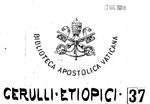There are 15 entities matching your text query for "አዕናቍ" with the parameters shown at the right. (searched: አዕናቍ)
Search time: 0.471 seconds.Chronicle of Galāwdewos
CAe 3122Clavis Aethiopica, an ongoing repertory of all known Ethiopic Textual Units. Use this to refer univocally to a specific text in your publications. Please note that this shares only the numeric part with the Textual Unit Record Identifier.
t:abAuthor attributions
Witnesses
- Oxford, Bodleian Library, Bodleian Bruce 88
- London, British Library, BL Oriental 821
- Paris, Bibliothèque nationale de France, BnF Éthiopien 143
- Frankfurt, Universitätsbibliothek Johann Christian Senckenberg, Frankfurt Ms. or. 38
- Paris, Bibliothèque nationale de France, BnF Éthiopien d'Abbadie 118
- Ethiopia, Tadbāba Māryām, not catalogued
Abstract
t:abSignatures
EMML6451Short Description
This parchment codex is composed of...ስለ፡ ኵልነ፡ እለ፡ ይትአመኑ፡ በኃይለ፡ ጸሎቶሙ፡ ለእሉ፡ ፪ቱ አዕናቍ፡ ክቡራብ፡ ወጽዱላን...
quoteSignatures
MAKM-101, C4-IV-60Short Description
This parchment codex is composed of... 132v: እጽሕፍ: ነገረ: አዕናቍ: ቀይሐን: ወኅብረ: ደም: ...
Gadla Ḥannā
CAe 1460Clavis Aethiopica, an ongoing repertory of all known Ethiopic Textual Units. Use this to refer univocally to a specific text in your publications. Please note that this shares only the numeric part with the Textual Unit Record Identifier.
| Clavis (list of identifiable texts) | ID | |
|---|---|---|
| BHOBibliotheca Hagiographica Orientalis | 60 | [check the Clavis Clavium] |
t:ab...ር፡ እምነ፡ ወርቅ፡ ወብሩር፡ ወትኄይስ፡ ፈድፋደ፡ እምነ፡ ፲ወ፪አዕናቍ፡ ዘዘዚአሁ፡ ኅብሮን፡ ...
incipitSignatures
BL Oriental 529, Wright cat. LIV, Wright 54Short Description
This parchment codex is composed ofንጽሕፍ፡ ትርጓሚ፡ ፲ወ፪አዕናቍ፡ ያስቢስ፡ ወጥልሞ፡ በኦሪት፡ ኢያስጲን፡ በሕዝቅኤል...
explicitSignatures
BL Oriental 718, Wright cat. CCXCV, Wright cat. 295Short Description
This parchment codex is composed of...ይለ፡ ጸሎቶሙ፡ ለእሉ፡ ክልኤሆሙ፡ አዕናቍ፡ ፅዱላን፡ እለ፡ ያዋክዩ፡ ወያበርሁ፡ በውስተ፡ ጽልመት፡ ...
Maṣḥafa falāsfā ṭabibān
CAe 7144Clavis Aethiopica, an ongoing repertory of all known Ethiopic Textual Units. Use this to refer univocally to a specific text in your publications. Please note that this shares only the numeric part with the Textual Unit Record Identifier.
abAbstract
This is the short recension of the . This recension is different from , especially in the second part of the work ((see )....አረጋዊ፡ አብድ። ተብህለ፡ እስመ፡ ተግሣጽሰ፡ ይከብር፡ እምነ፡ አዕናቍ፡ ክቡራት፡ ወ...
Miracle of ʾEwosṭātewos: the ruler who tried to take stones from the saint's sepulchre
CAe 6363Clavis Aethiopica, an ongoing repertory of all known Ethiopic Textual Units. Use this to refer univocally to a specific text in your publications. Please note that this shares only the numeric part with the Textual Unit Record Identifier.
abAbstract
... በአዕባን፡ አፍራፅ፡ ክቡራት፡ እለ፡ ያንጸበርቃ፡ ከመ፡ አዕናቍ፡ ወርቅ፡ ወከመ፡ ብረልያት፡ ቅዕድዋት። ...
titleSignatures
BnF Éthiopien 149, Éth. 119Short Description
This parchment codex is composed of...ተ፡ እግዚአብሔር፡ ጽሒፈ፡ ግብረተ፡ ደብተራ፡ ዘኦሪት። ነገረ፡ አዕናቍ።
incipitSignatures
BnF Éthiopien 157, Éth. 90Short Description
This parchment codex is composed of...አረጋዊ፡ አብድ። ተብህለ፡ እስመ፡ ተግሣጽሰ፡ ይከብር፡ እምነ፡ አዕናቍ፡ ክቡራት፡ ወያከብር፡ ...
Saint Petersburg, Institut Vostočnyh Rukopisej Rossijskoj Akademii Nauk, IV Ef. 67
titleSignatures
IV Ef. 67, IV Orlov27, Turaev cat. III.56Short Description
This parchment codex is composed ofTǝrgʷāme ʾaʿnāqʷ
CAe 4914Clavis Aethiopica, an ongoing repertory of all known Ethiopic Textual Units. Use this to refer univocally to a specific text in your publications. Please note that this shares only the numeric part with the Textual Unit Record Identifier.
titleAbstract
ትርጓሚ፡ ፲ወ፪አዕናቍ፡
Vatican City, Biblioteca Apostolica Vaticana, Biblioteca Apostolica Vaticana Cerulli 223
qSignatures
Biblioteca Apostolica Vaticana Cerulli 223Short Description
This parchment codex is composed of...፡ ኵልነ፡ እለ፡ ንትአመን፡ በኃይለ፡ ጸሎቶሙ፡ ለእሉ፡ ፪ሆሙ፡ አዕናቍ፡ ፅዱላን፡ እለ፡ ያዋክዩ፡ በውስተ፡ ጽልመት፨ ...
Vatican City, Biblioteca Apostolica Vaticana, Biblioteca Apostolica Vaticana Cerulli 37

qSignatures
Biblioteca Apostolica Vaticana Cerulli 37Short Description
This parchment codex is composed of...፡ ጸሎቶሙ፡ ለእሉ፡ ክልኤሆሙ፡ አዕናቍ፨ ጽዱላን፡ እለ፡ ያዋክዩ፡ በውስተ፡ ጽልመት፡ ይኩነነ፡ መ...
incipitSignatures
BGV-009, Zanutto 9Short Description
This parchment codex is composed of... በአዕባን፡ አፍራፅ፡ ክቡራት፡ እለ፡ ያንጸበርቃ፡ ከመ፡ አዕናቍ፡ ወርቅ፡ ወከመ፡ ብረልያት፡ ቅዕድዋት። ...


